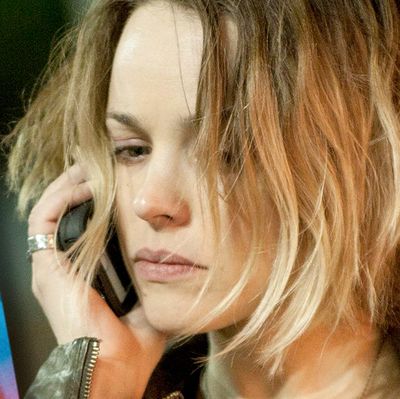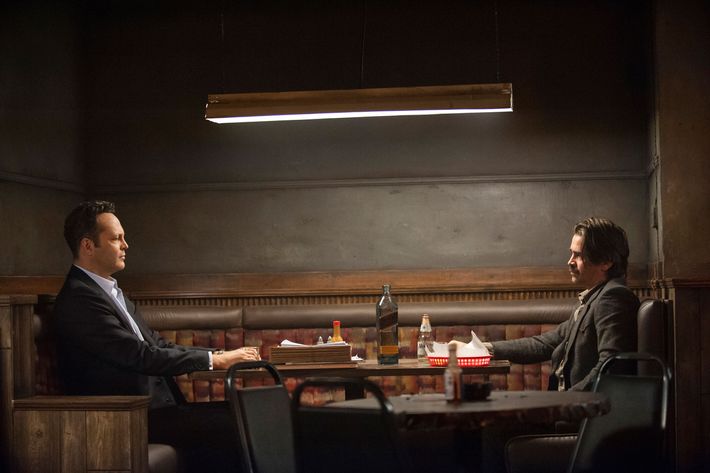
Spoilers ahead for the second season of True Detective.
The first season of True Detective was, if nothing else, a hotbed of references and influences — everything from Nietzsche to Robert Chambers’s book The King in Yellow to Orson Welles’s Touch of Evil to the films of Michael Mann. The arrival of the second season suggests things will be no different this time around — no matter what series creator Nic Pizzolatto and his directors may actually say. And one of the most prominent influences on this new season appears to be the work of David Lynch. Of course, Pizzolatto has made his fondness for Lynch known in the past, and the director’s Lost Highway felt like a key influence on last season as well. (Plus, Twin Peaks is already the granddaddy of most shows that feature an ongoing investigation over an entire season.) But based on what we’ve seen, here are just some of the ways the new season of True Detective reminds us of David Lynch.
Mulholland Drive Some have already remarked on the fact that a street sign with the words “Mulholland Dr.” on it is prominently featured early on — indeed, there’s a big, fat close-up of it — in the first episode. Not only that, but the car passing by the sign in question is carrying the dead body of Ben Caspere, the city controller whose death sets off this season’s featured investigation, and the episode repeatedly cuts to its journey. In Mulholland Drive, the crash of the car in question set off the plot of that movie, and the film repeatedly cuts back to its journey. Also, we don’t know that the figure of Caspere is dead at first — he’s got sunglasses on and is sitting straight in the backseat, next to a not-entirely-un-Lynchian black crow mask, which of course will return in episode two.
The décor. It is very hard not to think at least a little about Twin Peaks in the flashback where Ray Velcoro (Colin Farrell), in full L.A. sheriff’s department regalia, walks through a red door into a wood-paneled bar where Frank Semyon (Vince Vaughn) is sitting drinking coffee. It also feels like Ray is stepping into hell — which was an idea Twin Peaks played with as well. (Also, Blue Velvet, Lost Highway, Mulholland Drive … oh, right, every David Lynch movie is basically a journey into hell.)
Industrial blight. True Detective season two is set in and around the fictional city of Vinci, which we’re told is an industrial wasteland that’s effectively been given over to corrupt manufacturers for decades to do as they wish. Of course, industrial blight has been Lynch’s thing ever since his debut feature, Eraserhead. What’s notable about Lynch’s use of industrial imagery, however, is that it’s usually not particularly plot-oriented; he turns it into an abstraction and uses it to reveal his characters’ inner states of being. True Detective at first seems to treat the industry theme in more matter-of-fact fashion. However …
The soundtrack. The industrial noise and the low, bass rumbles heard throughout True Detective this season do feel very Lynchian and suggest that the show has taken that industrial aesthetic to heart in ways that go beyond mere plot — using this kind of heavily stylized sound design much the same way Lynch used it in Eraserhead, Lost Highway, and Inland Empire.

The songs. “Songs,” in this case, are different than “soundtrack.” Along with industrial noise and stomach-churning thrums, Lynch is well-known for prominently featuring dirgelike pop songs in his work, not just as a way to create mood but also as narrative and symbolic touchstones: “Blue Velvet” and “In Dreams” in Blue Velvet; “Crying”/”Llorando” in Mulholland Drive; Rammstein in Lost Highway; Julee Cruise’s songs in Twin Peaks; etc. It seems like True Detective’s new season has taken that idea to heart, most notably with Lera Lynn’s “My Least Favorite Life” in episode one and “The Rose” in episode three. Songs, it seems — sad, creepy, unsettling ones — are going to be a big part of this season. It’s worth pointing out that these songs aren’t just the usual type of soundtrack mood-filler: The action of the show often stops, or at least slows down, to indulge in these musical moments. This has attracted its fair share of criticism as well, but it also happens to be a thoroughly Lynchian concept.
Land development. In both True Detective and Twin Peaks, extra-legal machinations around land development seem to figure closely in the investigation of a murder. In Twin Peaks, local tycoon Ben Horne has nefarious plans to take over a local sawmill so he can turn it into a country club, while in True Detective a lot of local gangster Frank Semyon’s motivations have to do with trying to buy lucrative land being developed near an encroaching rail line. In both cases, of course, a line is drawn between American themes of development and expansion and horrific, perverse violence — a classic noir concept that both Pizzolatto and Lynch have clearly seized on.
Recording technology. David Lynch loves technology, and he loves using it in odd ways. So, too, does Nic Pizzolatto. In Twin Peaks, Agent Dale Cooper sent regular audiotaped missives to an unseen “Diane,” while audiotaped messages from Laura to her psychiatrist revealed key plot points; meanwhile, creepy-ass videos of Bill Pullman’s home in Lost Highway set that film’s “plot” into motion. In True Detective, we see Ray trading recordings with his troubled son Chad. There’s also a mysterious, remote-controlled video camera present when Ray is shot by a man in a crow’s mask, which may remind you of the voice-activated recording of a myna bird that witnessed a murder on Twin Peaks. Additionally, if there’s technology being used in weird ways, chances are porn is involved: We see this in Lost Highway, and True Detective has already given us a scene where Ani Bezzerides (Rachel McAdams) busts a porn webcam house where her sister is working (complete with chickens in the backyard).
Shooting the hero. At the end of season one of Twin Peaks, the show’s lead Agent Dale Cooper (Kyle MacLachlan) was unexpectedly shot by a masked gunman and left to die. At the end of episode two of this season of True Detective, Ray is shot by a masked gunman and left to die. Dale Cooper’s shooting, and his subsequent visit to what seemed like The Beyond, gave him important clues for season two. Which brings us to …
Conway Twitty in dream purgatory. As episode three begins, the just-shot Ray has a vision of himself sitting in a wood-paneled bar, having a highly symbolic, bizarre conversation with a younger version of his father, played by Fred Ward. (“Where is this?” “I don’t know. You’re here first.”) Meanwhile, Conway Twitty (or is it supposed to be a Conway Twitty impersonator, looking an awful lot like an Elvis impersonator?) sings “The Rose” in the background (read the story behind the song here). I’m not even sure where to start with this; I half-expected a “Guest Director: David Lynch” credit to float by on the screen after this moment. But suffice it to say that this half-dreamed visit to The Beyond will probably play some role in the remainder of this season, not unlike Dale Cooper’s own visitation after getting shot.
The dialogue. So far, this season has drawn its share of criticism — mainly for being too on-the-nose and filled with tough-guy clichés. To be fair, last season’s dialogue was also pretty portentous, but it was also delightfully weird, which undercut its self-importance. But True Detective’s general sense of self-conscious, surreal machismo is very much Lynchian — from its overt tough-guyisms (“This filth hurt your woman.” “I had a right, by any natural law”) to its oddball, overripe pronouncements. (“I like the bike. The highway suits me, sir. I am no good on the sidelines.” “Don’t ever do anything out of hunger. Not even eating.”)
A flamboyant psychiatrist. One of the most critical figures in the investigation into Laura Palmer’s murder on Twin Peaks turned out to be her very oddball psychiatrist, Dr. Lawrence Jacoby (played by onetime musical star Russ Tamblyn), who was fond of colorful shirts and cocktail umbrellas. So far, in True Detective, we’ve only met Ben Caspere’s psychiatrist (played by onetime rock star Rick Springfield) once, but he seems to be no less flamboyant, with his immobile face and his dandyish clothes (that ascot!). Something tells us we’ll see more of this guy as the season proceeds.
Surrealism. “You see that, too, right?” Caspere’s house is filled with weird fetish artwork and imagery, and this bizarre sculpture-installation-thingy of a miniature naked girl floating in a pool of milk might not even be the creepiest one. But it’s particularly mysterious because of the way it’s shot — as an insert, so we have no real sense of the scale of the thing. It looks just like a normal-size girl in a pool of milk. Lynch is a master of these kinds of offhand, dreamlike moments of surrealism — moments that make you catch yourself afterward and ask, “Wait, did I just see what I think I did?”
“What if I died there?” At the opening of episode two, Semyon lies in bed with his wife recounting a disturbing childhood memory about getting locked in the basement by his drunk father. He remembers how he was stuck there for five days when his father got arrested, and how he had to fight off some rats. “Ever since, I wonder, what if he never comes home?” Semyon muses. “What if I’m still in that basement, in the dark? What if I died there?” The thing that’s setting him off in this particular instance is two water stains above his bed. “Someone’s trying to tell me to wake up. Like I’m not real. Like I’m only dreaming.” Yes, this is probably Semyon’s way of noting that his money and power are whisper-thin. But this also recalls the big reveal at the end of Mulholland Drive, when we find out that the whole film has been, on some level, the dream of a dead woman, rotting away in a dark bedroom. And it also ties in with what appears so far to be a curious undercurrent of transcendence running throughout the show — an idea that ties directly with all of Lynch’s work, in which people often literally transcend levels of existence.


